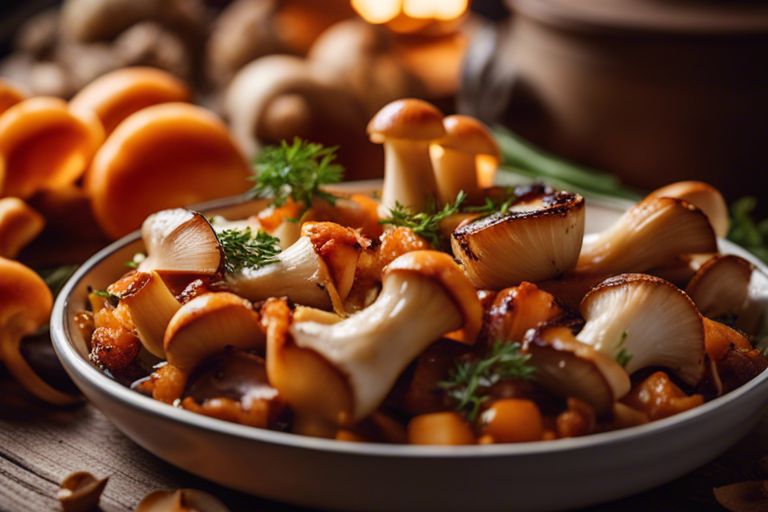Cooking Chicken of the Forest can be a rewarding experience for foragers looking to explore the world of wild mushrooms. Also known as Laetiporus, this bright orange fungus not only resembles the taste and texture of chicken but is also packed with nutrients like protein, fiber, and various vitamins. However, it is crucial to properly identify this mushroom as it bears a close resemblance to some toxic species. In this step-by-step guide, we will walk you through how to safely harvest, prepare, and savor this delicious wild delicacy.
Key Takeaways:
- Identify Correctly: Properly identify Chicken of the Forest mushrooms to ensure they are safe for consumption.
- Harvest Carefully: When foraging for Chicken of the Forest, cut the mushrooms cleanly at the base to ensure future growth.
- Cooking Method: Sauteing Chicken of the Forest with seasonings like garlic, butter, and herbs can enhance its flavor profile.
- Texture Consideration: Pay attention to the texture of the cooked mushrooms, as they should resemble chicken in consistency.
- Enjoy Creatively: Use Chicken of the Forest in various dishes such as pastas, soups, or as a meat substitute in recipes for a unique culinary experience.
Preparations Before Cooking
Identifying and Foraging Tips
Before you commence on a chicken of the forest foraging adventure, it’s crucial to be absolutely certain of what you’re picking. Identifying this wild mushroom correctly is vital to avoid any potential risks. Look for bright orange caps with shaggy edges that grow in shelving clusters on trees, particularly oak and beech. When foraging, take note of the surroundings as chicken of the forest prefers to grow at the base of trees.
- Identify bright orange caps with shaggy edges
- Grow in shelving clusters on oak and beech trees
- Check base of trees
The safety measure of properly identifying chicken of the forest cannot be emphasized enough. Be cautious and always double-check your finds before harvesting.
Cleaning and Storage
Before cooking your harvested chicken of the forest mushrooms, it’s crucial to clean and store them correctly to maintain their quality and ensure safety. An efficient method is to wipe the mushrooms with a damp cloth to remove any debris or dirt. You can also trim any damaged parts before storage.
With its unmistakable bright orange color and unique shaggy appearance, chicken of the forest is a prized find for many foragers. Keeping them clean and properly stored will help preserve their delicate flavor and ensure a safe culinary experience.
Cooking Techniques
Factors Affecting Cooking Methods
Some factors can influence the best cooking method for Chicken of the Forest mushrooms. The size and thickness of the mushroom slices, the desired texture, and the overall flavor profiles of the dish all play a role in determining the ideal technique. Baking or grilling may be best for larger, meatier slices, while sauteing or pan-frying can help achieve a crispy texture. Steaming or boiling may be preferable for softer, more delicate dishes. Assume that different methods will produce varied results, so experiment with different techniques to find your preferred cooking style.
Recipes and Serving Suggestions
With Chicken of the Forest, the possibilities for recipes and serving suggestions are endless. Any dish that traditionally uses chicken or mushrooms can be adapted to include this unique fungal delicacy. Try incorporating them into stir-fries, pasta dishes, or even as a pizza topping. Another way to enjoy this mushroom is by marinating and grilling them as a standalone dish or adding them to salads for a burst of umami flavor. Experiment with different flavors and cooking methods to see what suits your palate best.
Essential Tips for Enhancing Flavor
Now that you’ve harvested your Chicken of the Forest, it’s time to elevate its flavor profile to fully enjoy this unique fungi. Here are some vital tips to enhance the taste of your dish:
- Seasoning: Utilize a variety of herbs and spices to bring out the rich umami flavor of Chicken of the Forest. Consider options like thyme, rosemary, garlic, and black pepper to complement its earthy notes.
- Marinades: Experiment with different marinades to infuse additional flavors into the Chicken of the Forest. Try a mixture of olive oil, soy sauce, and balsamic vinegar for a savory twist.
Seasoning and Marinades
While preparing your Chicken of the Forest, it’s crucial to season it generously to enhance its natural taste. Marinating the fungi before cooking can also help tenderize it and infuse it with flavor, ensuring a delicious final dish.
Pairing with Other Foods
Seasoning your Chicken of the Forest properly is vital to ensure that its unique flavor shines through. Consider pairing it with grilled vegetables, pasta, or risotto to complement its earthy undertones. Additionally, creamy sauces or a splash of lemon juice can help balance out the dish and add depth to the overall flavor profile.
Foods like chicken, pork, or tofu can also be great companions to Chicken of the Forest, adding protein and texture to your meal. By experimenting with different pairings, you can create a well-rounded and satisfying dish that celebrates the unique taste of this wild mushroom.
This section will help you explore various flavor combinations to create a memorable dining experience with Chicken of the Forest.

Safety and Preservation
Recognizing Freshness and Spoilage
Many foragers often get excited when they find Chicken of the Forest mushrooms in the wild, but it’s crucial to be able to discern between freshness and spoilage. Some key indicators of freshness include a firm texture, vibrant color, and a pleasant earthy aroma. On the other hand, signs of spoilage include mushy texture, slimy surface, a sour or ammonia-like smell, or the presence of mold. To ensure your safety and culinary enjoyment, always inspect the mushrooms carefully before consumption.
Best Practices for Preservation
Many enthusiasts want to make their Chicken of the Forest mushrooms last longer. Practices such as drying, pickling, or freezing can help preserve the mushrooms for future use. Drying is a popular method that involves slicing the mushrooms and air-drying them until they are fully dehydrated. Pickling in vinegar or freezing in airtight containers are also effective ways to extend the shelf life of these prized fungi.
Understanding the importance of proper preservation techniques is vital for enjoying Chicken of the Forest mushrooms safely and deliciously. By recognizing the signs of freshness and spoilage and implementing best practices for preservation, you can savor these flavorful mushrooms in your favorite recipes with confidence.
To wrap up
Considering all points, mastering the art of cooking and enjoying Chicken of the Forest can be a rewarding experience. From identifying the mushroom to preparing it in delicious dishes, following a step-by-step guide is necessary for a safe and enjoyable culinary adventure. Remember to always forage for mushrooms responsibly, consult with an expert if unsure, and savor the unique flavors of this wild delicacy. With practice and patience, you can elevate your cooking skills and develop a deeper appreciation for the wonders of nature’s bounty.
FAQ
Q: What is Chicken of the Forest?
A: Chicken of the Forest, also known as Laetiporus, is a type of wild mushroom that grows in shelf-like clusters on trees. It is commonly referred to as the “chicken mushroom” due to its texture and flavor that resembles chicken when cooked.
Q: How do I identify Chicken of the Forest in the wild?
A: Chicken of the Forest can be identified by its bright orange to yellowish color, its shelf-like appearance growing on the side of trees, and the absence of gills on the underside. It typically grows on oak, cherry, and other hardwood trees during the late summer and fall months.
Q: How can I cook and enjoy Chicken of the Forest mushrooms?
A: To cook Chicken of the Forest mushrooms, start by cleaning them thoroughly and slicing them into desired sizes. You can then sauté them with butter, garlic, and herbs for a delicious side dish, or bread and fry them for a crispy appetizer. The mushrooms can also be added to soups, stews, and pasta dishes to enhance their flavor.

